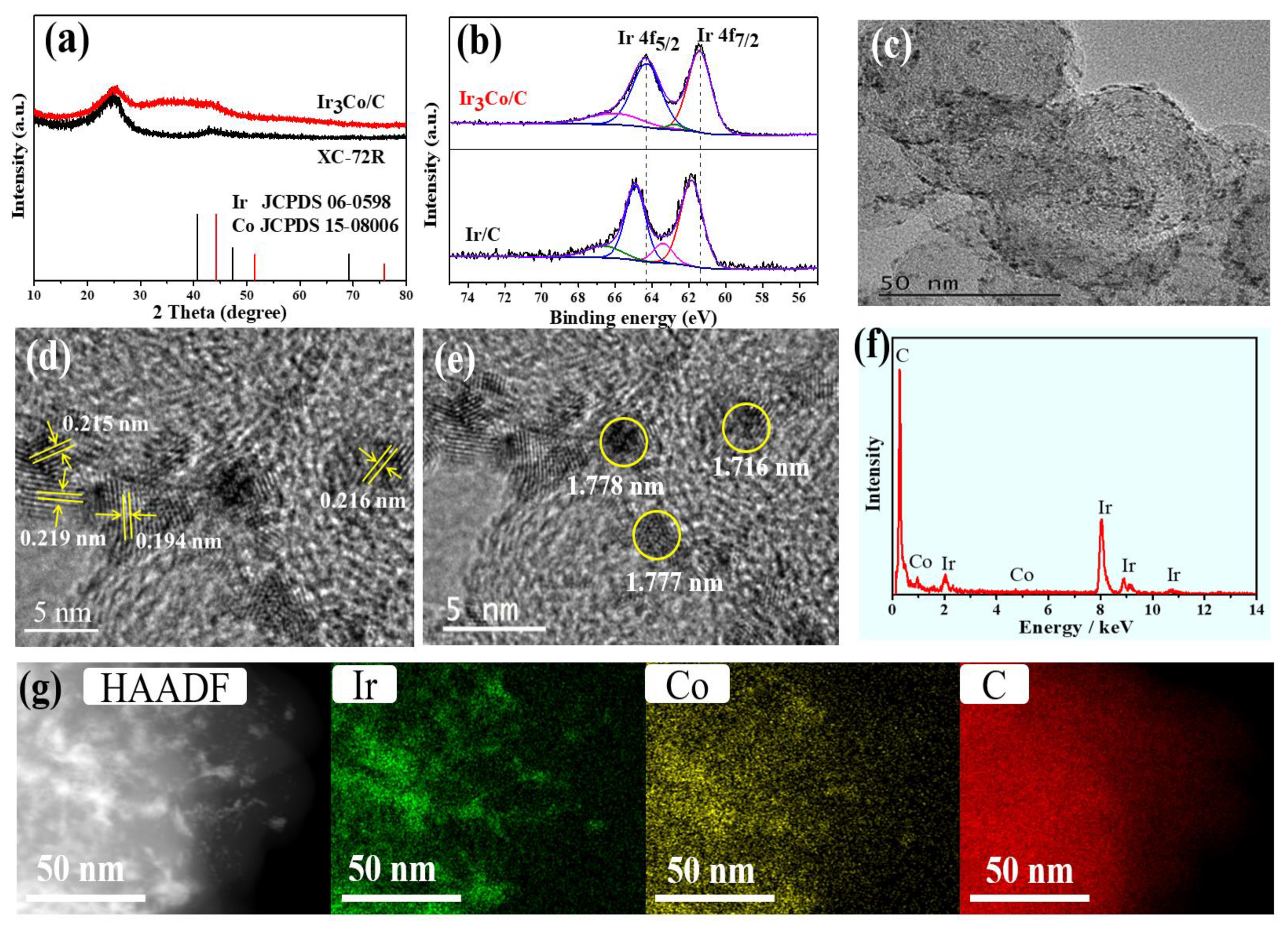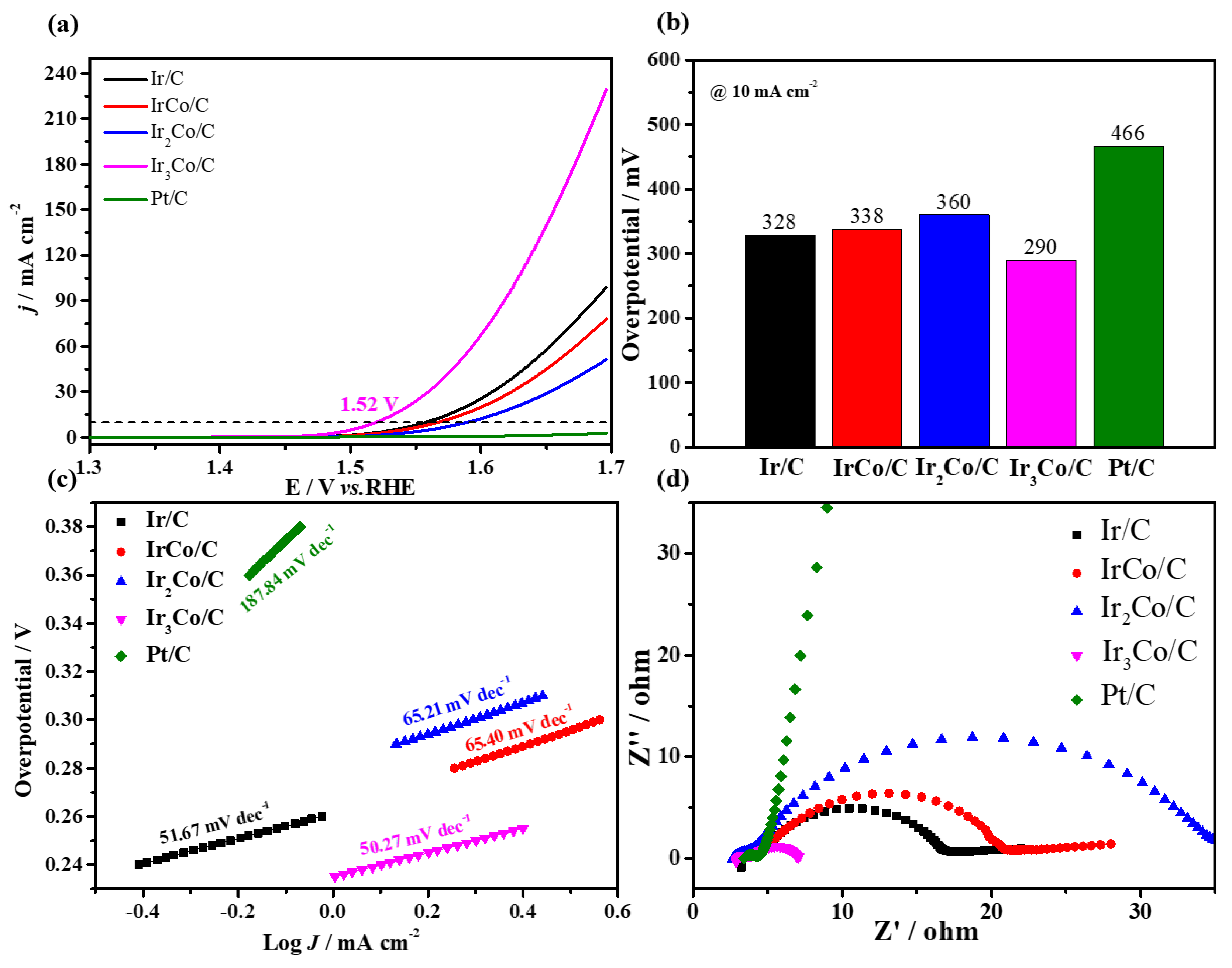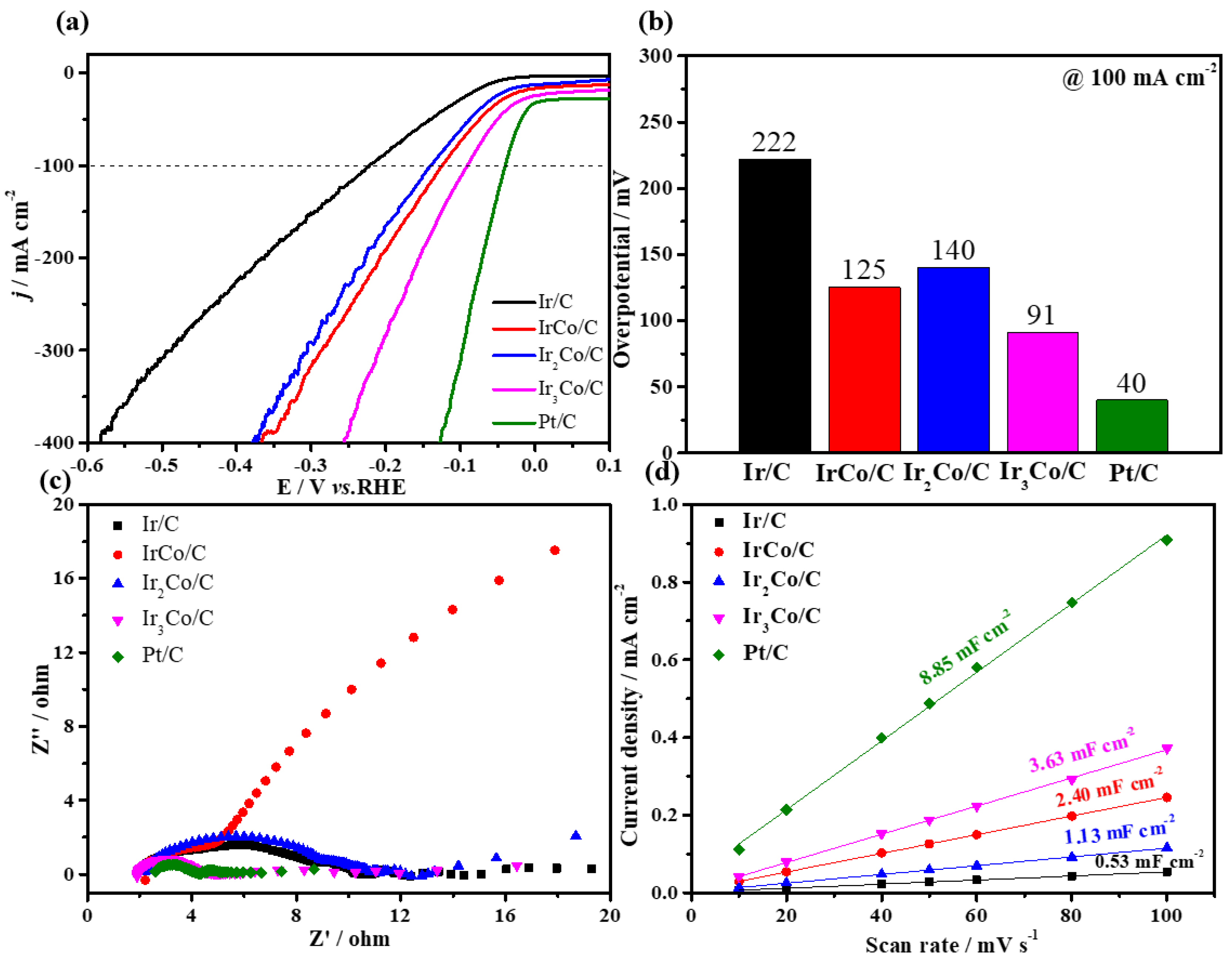Controllable Construction of IrCo Nanoclusters and the Performance for Water Electrolysis
Abstract
:1. Introduction
2. Results and Discussion
3. Materials and Methods
3.1. Experimental Materials and Material Characterization
3.1.1. Experimental Materials
3.1.2. Materials Characterization
3.1.3. Preparation of Working Electrode
- Nafion (5%), ultra-pure water and ethanol were used to prepare slurry at 1:9:10.
- 5 mg catalyst was mixed with 1 mL of the slurry.
- Ultrasonic to uniform dispersion.
- The pipette gun was used to take 16 μL of the slurry and uniformly add it to the carbon paper with an area of 0.25 cm2.
- The working electrode load obtained was 0.32 mg cm−2.
3.2. Material Synthesis
3.3. Electrochemical Measurements
4. Conclusions
Supplementary Materials
Author Contributions
Funding
Data Availability Statement
Conflicts of Interest
References
- Cui, X.; Chen, M.; Xiong, R.; Sun, J.; Liu, X.; Geng, B. Ultrastable and efficient H2 production via membrane-free hybrid water electrolysis over a bifunctional catalyst of hierarchical Mo–Ni alloy nanoparticles. J. Mater. Chem. A 2019, 7, 16501–16507. [Google Scholar] [CrossRef]
- Chen, L.-W.; Liang, H.-W. Ir-based bifunctional electrocatalysts for overall water splitting. Catal. Sci. Technol. 2021, 11, 4673–4689. [Google Scholar] [CrossRef]
- Qazi, U.Y.; Javaid, R.; Tahir, N.; Jamil, A.; Afzal, A. Design of advanced self-supported electrode by surface modification of copper foam with transition metals for efficient hydrogen evolution reaction. Int. J. Hydrog. Energy 2020, 45, 33396–33406. [Google Scholar] [CrossRef]
- Yang, F.; Chen, X.; Li, Z.; Wang, D.; Liu, L.; Ye, J. Ultrathin FeP nanosheets as an efficient catalyst for electrocatalytic water oxidation: Promoted intermediates adsorption by surface defects. ACS Appl. Energy Mater. 2020, 3, 3577–3585. [Google Scholar] [CrossRef]
- Tian, L.; Zhai, X.; Wang, X.; Li, J.; Li, Z. Advances in manganese-based oxides for oxygen evolution reaction. J. Mater. Chem. A 2020, 8, 14400–14414. [Google Scholar] [CrossRef]
- Alia, S.M.; Shulda, S.; Ngo, C.; Pylypenko, S.; Pivovar, B.S. Iridium-based nanowires as highly active, oxygen evolution reaction electrocatalysts. ACS Catal. 2018, 8, 2111–2120. [Google Scholar] [CrossRef]
- Jiang, P.; Chen, J.; Wang, C.; Yang, K.; Gong, S.; Liu, S.; Lin, Z.; Li, M.; Xia, G.; Yang, Y.; et al. Tuning the activity of carbon for electrocatalytic hydrogen evolution via an Iridium-Cobalt alloy core encapsulated in nitrogen-doped carbon cages. Adv. Mater. 2018, 30, 1705324. [Google Scholar] [CrossRef]
- Zhao, X.; Chang, Y.; Ji, J.; Jia, J.; Jia, M. Ultradispersed IrxNi clusters as bifunctional electrocatalysts for high-efficiency water splitting in acid electrolytes. RSC Adv. 2021, 11, 33179–33185. [Google Scholar] [CrossRef]
- Zhao, Y.; Luo, M.; Chu, S.; Peng, M.; Liu, B.; Wu, Q.; Liu, P.; de Groot, F.M.F.; Tan, Y. 3D nanoporous iridium-based alloy microwires for efficient oxygen evolution in acidic media. Nano Energy 2019, 59, 146–153. [Google Scholar] [CrossRef]
- Wang, H.; Chen, Z.N.; Wu, D.; Cao, M.; Sun, F.; Zhang, H.; You, H.; Zhuang, W.; Cao, R. Significantly enhanced overall water splitting performance by partial oxidation of Ir through Au modification in core-shell alloy structure. J. Am. Chem. Soc. 2021, 143, 4639–4645. [Google Scholar] [CrossRef]
- Zhu, J.; Chen, Z.; Xie, M.; Lyu, Z.; Chi, M.; Mavrikakis, M.; Jin, W.; Xia, Y. Iridium-based cubic nanocages with 1.1-nm-thick walls: A highly efficient and durable electrocatalyst for water oxidation in an acidic medium. Angew. Chem. Int. Ed. 2019, 58, 7244–7248. [Google Scholar] [CrossRef] [PubMed]
- Battiato, S.; Bruno, L.; Terrasi, A.; Mirabella, S. Superior performances of electroless-deposited Ni–P films decorated with an ultralow content of Pt for water-splitting reactions. ACS Appl. Energy Mater. 2022, 5, 2391–2399. [Google Scholar] [CrossRef]
- Qazi, U.Y.; Javaid, R.; Zahid, M.; Tahir, N.; Afzal, A.; Lin, X.-M. Bimetallic NiCo–NiCoO2 nano-heterostructures embedded on copper foam as a self-supported bifunctional electrode for water oxidation and hydrogen production in alkaline media. Int. J. Hydrog. Energy 2021, 46, 18936–18948. [Google Scholar] [CrossRef]
- Wang, F.; Kusada, K.; Wu, D.; Yamamoto, T.; Toriyama, T.; Matsumura, S.; Nanba, Y.; Koyama, M.; Kitagawa, H. Solid-solution alloy nanoparticles of the immiscible Iridium-Copper system with a wide composition range for enhanced electrocatalytic applications. Angew. Chem. Int. Ed. 2018, 57, 4505–4509. [Google Scholar] [CrossRef]
- Feng, J.; Lv, F.; Zhang, W.; Li, P.; Wang, K.; Yang, C.; Wang, B.; Yang, Y.; Zhou, J.; Lin, F.; et al. Iridium-based multimetallic porous hollow nanocrystals for efficient overall-water-splitting catalysis. Adv. Mater. 2017, 29, 1703798. [Google Scholar] [CrossRef]
- Park, J.; Sa, Y.J.; Baik, H.; Kwon, T.; Joo, S.H.; Lee, K. Iridium-based multimetallic nanoframe@nanoframe structure: An efficient and robust electrocatalyst toward oxygen evolution reaction. ACS Nano 2017, 11, 5500–5509. [Google Scholar] [CrossRef]
- Chang, J.; Zang, S.; Li, J.; Wu, D.; Lian, Z.; Xu, F.; Jiang, K.; Gao, Z. Nitrogen-doped porous carbon encapsulated nickel iron alloy nanoparticles, one-step conversion synthesis for application as bifunctional catalyst for water electrolysis. Electrochim. Acta 2021, 389, 138785. [Google Scholar] [CrossRef]
- Liu, S.; Hu, Z.; Wu, Y.; Zhang, J.; Zhang, Y.; Cui, B.; Liu, C.; Hu, S.; Zhao, N.; Han, X.; et al. Dislocation-strained IrNi alloy nanoparticles driven by thermal shock for the hydrogen evolution reaction. Adv. Mater. 2020, 32, 2006034. [Google Scholar] [CrossRef]
- Xu, J.; Li, J.; Lian, Z.; Araujo, A.; Li, Y.; Wei, B.; Yu, Z.; Bondarchuk, O.; Amorim, I.; Tileli, V.; et al. Atomic-step enriched ruthenium–iridium nanocrystals anchored homogeneously on MOF-derived support for efficient and stable oxygen evolution in acidic and neutral media. ACS Catal. 2021, 11, 3402–3413. [Google Scholar] [CrossRef]
- Hu, H.; Lei, X.; Li, S.; Fu, L.; Peng, R.; Ren, X.; Wang, J. FeCo alloy nanoparticles obtained by PVP modified oxalate template method as an efficient oxygen evolution reaction catalyst. J. Met. 2021, 74, 346–353. [Google Scholar] [CrossRef]
- Zhang, Q.; Yang, X.; Guan, J. Applications of magnetic nanomaterials in heterogeneous catalysis. ACS Appl. Nano Mater. 2019, 2, 4681–4697. [Google Scholar] [CrossRef]
- Huang, Y.; Zhang, S.L.; Lu, X.F.; Wu, Z.P.; Luan, D.; Lou, X.W.D. Trimetallic spinel NiCo2-xFexO4 nanoboxes for highly efficient electrocatalytic oxygen evolution. Angew. Chem. Int. Ed. 2021, 60, 11841–11846. [Google Scholar] [CrossRef] [PubMed]
- Wang, Q.; Ming, M.; Niu, S.; Zhang, Y.; Fan, G.; Hu, J.-S. Scalable solid-state synthesis of highly dispersed uncapped metal (Rh, Ru, Ir) nanoparticles for efficient hydrogen evolution. Adv. Energy Mater. 2018, 8, 1801698. [Google Scholar] [CrossRef]
- Li, S.; Xu, Y.; Chen, Y.; Li, W.; Lin, L.; Li, M.; Deng, Y.; Wang, X.; Ge, B.; Yang, C.; et al. Tuning the selectivity of catalytic carbon dioxide hydrogenation over iridium/cerium oxide catalysts with a strong metal-support interaction. Angew. Chem. Int. Ed. 2017, 56, 10761–10765. [Google Scholar] [CrossRef]
- Sun, H.; Ding, Z.; Sun, H.; Li, S.; Lavernia, E.J.; Liu, W. The synergistic effects of energy barriers and shear directions on twinning in face centered cubic metals. Comput. Mater. Sci. 2020, 177, 1095477. [Google Scholar] [CrossRef]
- Guo, F.; Zou, Z.; Zhang, Z.; Zeng, T.; Tan, Y.; Chen, R.; Wu, W.; Cheng, N.; Sun, X. Confined sub-nanometer PtCo clusters as a highly efficient and robust electrocatalyst for the hydrogen evolution reaction. J. Mater. Chem. A 2021, 9, 5468–5474. [Google Scholar] [CrossRef]
- Strickler, A.L.; Flores, R.A.; King, L.A.; Norskov, J.K.; Bajdich, M.; Jaramillo, T.F. Systematic investigation of iridium-based bimetallic thin film catalysts for the oxygen evolution reaction in acidic media. ACS Appl. Mater. Interfaces 2019, 11, 34059–34066. [Google Scholar] [CrossRef]
- Fang, D.; Tang, X.; Yang, L.; Xu, D.; Zhang, H.; Sun, S.; Shao, Z.; Yi, B. Facile synthesis of Pt-decorated Ir black as a bifunctional oxygen catalyst for oxygen reduction and evolution reactions. Nanoscale 2019, 11, 9091–9102. [Google Scholar] [CrossRef]
- Lim, J.; Park, D.; Jeon, S.S.; Roh, C.-W.; Choi, J.; Yoon, D.; Park, M.; Jung, H.; Lee, H. Ultrathin IrO2 nanoneedles for electrochemical water oxidation. Adv. Funct. Mater. 2018, 28, 1704796. [Google Scholar] [CrossRef]
- Sharma, L.; Katiyar, N.K.; Parui, A.; Das, R.; Kumar, R.; Tiwary, C.S.; Singh, A.K.; Halder, A.; Biswas, K. Low-cost high entropy alloy (HEA) for high-efficiency oxygen evolution reaction (OER). Nano Res. 2021, 15, 4799–4806. [Google Scholar] [CrossRef]
- Zhu, K.; Wu, T.; Li, M.; Lu, R.; Zhu, X.; Yang, W. Perovskites decorated with oxygen vacancies and Fe-Ni alloy nanoparticles as high-efficiency electrocatalysts for the oxygen evolution reaction. J. Mater. Chem. A 2017, 5, 19836–19845. [Google Scholar] [CrossRef]
- Najafi, L.; Bellani, S.; Oropesa-Nuñez, R.; Martín-García, B.; Prato, M.; Mazánek, V.; Debellis, D.; Lauciello, S.; Brescia, R.; Sofer, Z.; et al. Niobium disulphide (NbS2)-based (heterogeneous) electrocatalysts for an efficient hydrogen evolution reaction. J. Mater. Chem. A 2019, 7, 25593–25608. [Google Scholar] [CrossRef]
- Ahmed, J.; Alhokbany, N.; Ahamad, T.; Alshehri, S.M. Investigation of enhanced electro-catalytic HER/OER performances of copper tungsten oxide@reduced graphene oxide nanocomposites in alkaline and acidic media. New J. Chem. 2022, 46, 1267–1272. [Google Scholar] [CrossRef]
- Ling, Y.; Kazim, F.M.D.; Zhang, Q.; Xiao, S.; Li, M.; Yang, Z. Construction of Mo2C/W2C heterogeneous electrocatalyst for efficient hydrogen evolution reaction. Int. J. Hydrog. Energy 2021, 46, 9699–9706. [Google Scholar] [CrossRef]
- Jing, Y.; Liu, H.; Yan, R.; Chen, J.; Dai, H.; Liu, C.; Zhang, X.-D. Mesoporous CoP Nanowire Arrays for Hydrogen Evolution. ACS Appl. Nano Mater. 2019, 2, 5922–5930. [Google Scholar] [CrossRef]
- Tong, J.; Li, T.; Bo, L.; Li, W.; Li, Y.; Zhang, Q. Greatly improved HER electrocatalytic activity by the composite of CoSe2 and N, S-dual doped graphitic carbon. Int. J. Hydrog. Energy 2019, 44, 13424–13431. [Google Scholar] [CrossRef]



Publisher’s Note: MDPI stays neutral with regard to jurisdictional claims in published maps and institutional affiliations. |
© 2022 by the authors. Licensee MDPI, Basel, Switzerland. This article is an open access article distributed under the terms and conditions of the Creative Commons Attribution (CC BY) license (https://creativecommons.org/licenses/by/4.0/).
Share and Cite
Mao, F.; Zhao, X.; Chang, Y.; Jia, J. Controllable Construction of IrCo Nanoclusters and the Performance for Water Electrolysis. Catalysts 2022, 12, 914. https://doi.org/10.3390/catal12080914
Mao F, Zhao X, Chang Y, Jia J. Controllable Construction of IrCo Nanoclusters and the Performance for Water Electrolysis. Catalysts. 2022; 12(8):914. https://doi.org/10.3390/catal12080914
Chicago/Turabian StyleMao, Fangqin, Xiaojie Zhao, Ying Chang, and Jingchun Jia. 2022. "Controllable Construction of IrCo Nanoclusters and the Performance for Water Electrolysis" Catalysts 12, no. 8: 914. https://doi.org/10.3390/catal12080914
APA StyleMao, F., Zhao, X., Chang, Y., & Jia, J. (2022). Controllable Construction of IrCo Nanoclusters and the Performance for Water Electrolysis. Catalysts, 12(8), 914. https://doi.org/10.3390/catal12080914




